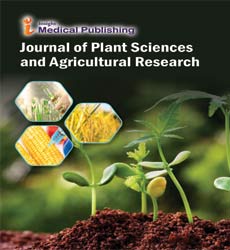Gene Transfer: Transforming Agriculture and Medicine
Isamu Yamamoto*
Department of Biotechnology, Hokkaido University, Sapporo, Japan
- *Corresponding Author:
- Isamu Yamamoto
Department of Biotechnology, Hokkaido University, Sapporo,
Japan,
E-mail: yamamoto_i@husk.jp
Received date: August 23, 2024, Manuscript No. IPJPSAR-24-19139; Editor assigned date: August 26, 2024, PreQC No. IPJPSAR-24-19139 (PQ); Reviewed date: September 09, 2024, QC No. IPJPSAR-24-19139; Revised date: September 17, 2024, Manuscript No. IPJPSAR-24-19139 (R); Published date: September 24, 2024, DOI: 10.36648/ipjpsar.8.3.150
Citation: Yamamoto I (2024) Gene Transfer: Transforming Agriculture and Medicine. J Plant Sci Agri Res Vol.8 No.3: 150.
Description
Gene transfer, a fundamental process in genetics and biotechnology, refers to the transmission of genetic material from one organism to another. This mechanism plays a vital role in various biological processes, including reproduction, evolution and the development of genetic diversity. In biotechnology, gene transfer serves as a fundamental for genetic engineering, enabling scientists to manipulate the genetic makeup of organisms for a wide range of applications, from basic research to agricultural and medical advancements.
One of the primary methods used for gene transfer is recombinant DNA technology, which involves the insertion of foreign genes into the genome of a host organism. This process typically begins with the identification and isolation of the gene of interest, followed by its insertion into a vector, such as a plasmid or viral genome, which serves as a carrier for delivering the gene into the host organism's cells. Once inside the host cells, the vector introduces the foreign gene into the genome, where it can be expressed and produce the desired protein or trait.
Gene transfer techniques have revolutionized various fields of science and technology, offering unprecedented opportunities for research, innovation and practical applications. In agriculture, genetic engineering has been used to develop genetically modified crops with improved traits such as resistance to pests, diseases and herbicides, as well as enhanced nutritional content and agronomic performance. These GM crops have contributed to increased crop yields, reduced chemical inputs and improved food security for millions of people worldwide.
Moreover, gene transfer plays a vital role in medical biotechnology, particularly in the production of recombinant proteins and gene therapy. Recombinant proteins, such as insulin, growth hormones and clotting factors, are produced by genetically engineered microorganisms or mammalian cells and used for treating various medical conditions, including diabetes, growth disorders and hemophilia. Gene therapy, on the other hand, involves the introduction of therapeutic genes into patients' cells to correct genetic disorders, restore normal cellular function, or enhance the body's ability to fight disease.
In addition to its applications in agriculture and medicine, gene transfer has numerous other biotechnological applications, including the production of industrial enzymes, biofuels, bioplastics and bioremediation agents. Enzymes produced through genetic engineering are used in various industrial processes, such as food and beverage production, textile manufacturing and waste treatment, offering environmentally friendly and cost-effective alternatives to traditional chemicalbased methods.
Genetic diversity
Despite its transformative potential, gene transfer is not without challenges and ethical considerations. Concerns about biosafety, environmental impact and unintended consequences of genetic manipulation have prompted regulatory agencies to establish stringent guidelines and regulations governing the use of genetically modified organisms and genetically engineered products. Furthermore, public perception and acceptance of Genetically Modified Organisms (GMO) vary widely, with some advocating for their potential benefits in addressing global challenges such as food insecurity and climate change, while others raise concerns about their long-term safety and environmental impact.
Looking ahead, gene transfer technologies are poised to continue driving innovation and shaping the future of biotechnology, agriculture and medicine. Ongoing research efforts focus on developing advanced gene editing tools, such as CRISPR-Cas9, that enable precise and efficient modification of genomes, opening up new possibilities for targeted gene therapy, functional genomics and synthetic biology. Furthermore, advances in synthetic biology and metabolic engineering are paving the way for the design and construction of novel biological systems with tailored functions and capabilities, ranging from biofuel production to drug discovery.
Conclusion
Gene transfer is a powerful tool that underpins a wide range of applications in genetics, biotechnology and beyond. From improving crop productivity and sustainability to advancing medical treatments and therapies, gene transfer technologies offer transformative solutions to some of the most pressing challenges facing society today. However, responsible stewardship, ethical considerations and continued innovation are essential to harnessing the full potential of gene transfer for the benefit of humanity and the environment.
Open Access Journals
- Aquaculture & Veterinary Science
- Chemistry & Chemical Sciences
- Clinical Sciences
- Engineering
- General Science
- Genetics & Molecular Biology
- Health Care & Nursing
- Immunology & Microbiology
- Materials Science
- Mathematics & Physics
- Medical Sciences
- Neurology & Psychiatry
- Oncology & Cancer Science
- Pharmaceutical Sciences
